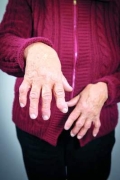AT CARDIOVASCULAR RESEARCH TECHNOLOGIES 2016
WASHINGTON (FRONTLINE MEDICAL NEWS) Treating all of the estimated 23 million individuals in the United States who would qualify for PCSK9 inhibitor therapy on the basis of current Food and Drug Administration indications and insurance company reimbursement criteria may be cost effective, according to data extrapolated from a tertiary center lipid clinic.
That is, if the two approved PCSK9 inhibitors are shown to reduce cardiovascular events in outcome studies.
With the current annual cost of PCSK9 therapy estimated to be roughly $14,000 per patient, the total bill for treating all candidates is an estimated $320 billion per year, but this huge sum may be offset by savings in medical care and lost productivity, Dr. Marloe Prince said at Cardiovascular Research Technologies 2016.
“Cost is a real issue for PCSK9 inhibitors,” reported Dr. Prince, an internal medicine resident at Jewish Hospital in Cincinnati. “Our aim was to determine first what percentage of patients would quality for PCSK9 inhibitor therapy and then to perform a cost efficacy analysis based on these estimates.”
The two PCSK9 inhibitors approved for lowering LDL cholesterol, evolocumab and alirocumab, are priced similarly. Both reduce LDL cholesterol by about 60% in most patients. Several published trials have demonstrated that PCSK9 inhibitors, which are administered by injection at intervals ranging from 2 weeks to 1 month, can bring a substantial proportion of high-risk patients to guideline recommended goals when maximally tolerated statins fail to do so.
In this study, the first step was to determine what proportion of patients referred to a lipid clinic for inadequate control of LDL cholesterol are eligible for PCSK9 inhibitors on the basis of current FDA indications and commercial insurance criteria. These indications include LDL cholesterol levels above guideline recommended targets in patients on maximally tolerated statins with heterozygous (HeFH) or homozygous (HoFH) familial hypercholesterolemia as well as those who have had a previous cardiovascular event.
Of 734 consecutive patients referred to the lipid clinic and had been managed for at least 2 months on maximally tolerated statins, 220 (30%) were eligible for a PCSK9 prescription on the basis of both the current FDA indication and commercial insurance reimbursement criteria. Applying this 30% figure to previously published estimates of patients not at goal on maximally tolerated statins, Dr. Prince and his coinvestigators estimated that there are 23 million Americans with hypercholesterolemia who would similarly qualify for a PCSK9 inhibitor.
The cost of supplying all 23 million individuals with a PCSK9 inhibitor is roughly $322 billion annually, but Dr. Prince cited data indicating that the estimated costs for treating cardiovascular events and stroke per year is also about $320 billion. Outcome trials with PCSK9 inhibitors have not yet been completed, but the estimate of the risk reduction based on preliminary data is 50%.
“If the preliminary findings are correct, PCSK9 inhibitors would be expected to provide direct savings of $160 billion,” Dr. Prince said. These savings are less surprising when current average costs for a single percutaneous coronary intervention at $70,000, Dr. Prince said at the meeting, sponsored by the Cardiovascular Research Institute at Washington Hospital Center.
“In addition, indirect saving from avoiding loss of productivity and even death is reasonably estimated to be in the range of $170 billion,” said Dr. Prince, citing data that would support these figures.
While he acknowledged the limitations of extrapolating data from a single center for these cost estimates, Dr. Prince suggested this is a useful exercise for considering the role of these agents, which provide an unprecedented opportunity to bring high-risk patients to guideline recommended LDL-C goals. Of the weaknesses of the study, however, the most important may be the absence of level 1 evidence that the cardiovascular risk reductions provided by PCSK9 inhibitors will be commensurate with their potent lipid lowering. Data from the ongoing outcome trials are more than a year away.



